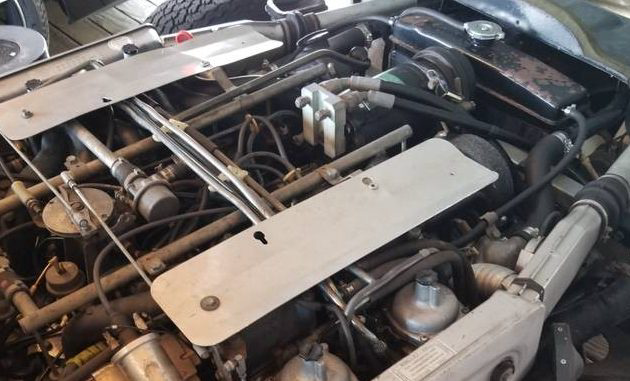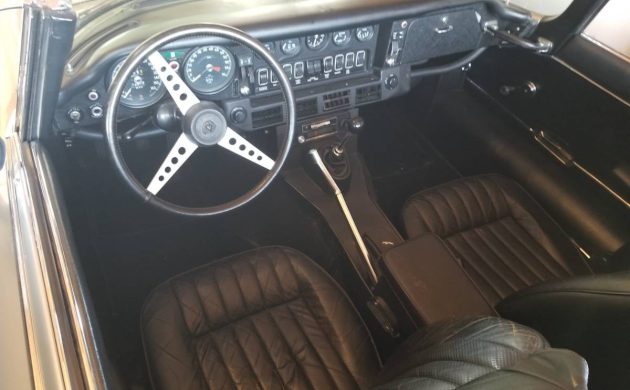Jaguar gave its groundbreaking XKE a final update in 1971, imposing both excitement and trouble upon its devotees. This revision dealt with the creeping horsepower suppression that hounded all carmakers in the 1970s, but it also transformed the car from a pure sports car to something more akin to a GT. Rather than the free-revving six-cylinder that Jaguar had made famous, the company bestowed the Series 3 XKE with an alloy 5.3-liter V12 decked with four carburetors and a host of compensations to balance economy and emissions. Powerful, yes, and not much heavier than the six, but also mechanically complex. The car grew dimensionally, too: all Series 3s utilized the larger 2+2 chassis, and to emphasize its new presence, the fenders were flared and the grille was widened. Those ungainly bumpers were forced upon US delivery cars starting in 1973, and large though they may be, they weren’t protective enough to prevent damage to this E-Type’s bonnet. This car is located in Mill City, California; it’s had one owner and traveled only 25,000 miles.
Development of Jaguar’s V12 began in the 1950s as part of the company’s race program. Configurations and displacements changed over the years, until in the 1960s, a 5.3-liter, single-overhead-cam was deemed suitable for production. Originally designed for fuel injection, it instead carried four Zenith-Stromberg carburetors. By the mid-70s, the engine’s compression ratio was reduced to cater to emissions regulations, so output was a moving target, beginning at about 270 hp and settling at about 240 hp. The OPUS Lucas electronic ignition was mounted between the heads and suffered from overheating; the cooling system was also not always up to snuff. In keeping with its demeanor as a touring car, both an automatic and a manual were available, as well as air conditioning. As noted, the odometer reads 24,272 miles, and the car’s history is known, supporting the mileage claim. A thorough service was recently performed, and the car has new tires, a new battery, and a new fuel pump.
A four-speed manual brings power to the rear wheels; the seller notes that the interior still smells like fresh leather. By the time the Series 3 rolled off the line, the lovely wood-rimmed steering wheel had given way to an anonymous black variant, fading into the dash. The top hasn’t been put up in over thirty years, and while it’s represented as pristine, it may have shrunk to the point of uselessness. The 105″ wheelbase – up from the 96″ of the Series 2 – expanded the interior considerably but at the cost of an extra six-hundred pounds.
The silver paint is original and shines nicely, though this color can hide flaws … we already saw that the delicate bonnet bears a couple of dents. If a low mileage V12 E-Type is on your bucket list, this one can be found on craigslist, with an asking price of $105,000. A close comparator is this 20,000-mile example listed for sale here, priced at $109,900. One can certainly pay less for a V12 E-Type, but pursuing the best will likely cost six figures. Thanks to Tony Primo for finding this swanky cat for us!




Always loved the V12 E type. Not a fan of convertibles tho, but hey I live in Australia, nuf said?
And Michelle, you had to mention the Prince of Darkness, (Lucus ) lol
Unfortunately the Yanks just can’t let go of the Lucas jibe. Like the American cars were flawless, yeah right. I have owned MANY British cars with Lucas electrics and can honestly say that I don’t remember having any serious, costly problems with ANY of them. From some of the comments I have read here over the years there seem to have been about as many disasters with American cars as with the British cars as all manufacturers produced vehicles with faults, just some more than others, it’s just that us Brits that have owned American cars don’t go on and on about their faults, we just learned to live with them.
Many people only have other people’s opinions to go by. For them it was the reports of auto journalists they read in the pages of CD, MT and R&T. This is where the rip on Lucas may have originated and it managed to stick. If the writers want to crucify a vehicle they will. Rightfully or otherwise.
Must be parts shots in barns week.
as noted, in the write-up, the purists will definitely favor the early cars, especially the Series 1 over these last series V12, but I’d say it’s all relative…a series 3 E-type is still a highly desirable car. Nice to see the manual transmission, and even with the compromises to emission’s controls this would have been considered a pretty fast car by early 70s standards.
its always open to debate about the mileage claim when there is no extra digit on the odometer – but under the hood this one does seem pretty clean so maybe its true. The seats seem to have limited wear.
Looking at the photo of the front end, it seems to me that the damage may be mainly to the chrome trim rather than the steel bonnet panel? in which case it would we relatively simple to fix by just sourcing a good replacement trim?
I’ve owned one of each: a Ser 1 and a Ser 3. There is no reason not to love both! The OPUS ignition is very easily replaced with an available modern optical unit. Then you’re off to the races!
Putting your foot into a v12 is a very satisfying thing to be able to do! Even the big Mercedes v12 sedan moved along very nicely with one.
When I was a kid, the whole idea of an “E-Type V12” was INCREDIBLY exotic. I even made a bet with my dad, that if I, a 10 year old playing violin in the school orchestra, could play La ronde des Lutins (which is basically Van Halen on the violin), he’d buy me a Jaguar E-type V12. He even got me the sheet music.
I couldn’t get past the first note.
Years later, I asked him about it, and he said “Look, it was a safe bet. But on the very off chance that you could play it, you wouldn’t need me to buy it for you…”
I love your Dad’s reply! He obviously knew a thing or two about where you would be heading if you could play La ronde des Lutins!
Saw in a different post that the upvote wasn’t working, Not working for me here either.
Not for me either, it happens sometimes.
I will never forget as a young man living in Southern California, my next door neighbor had one of these. His was a 73 V-12 roadster in a silver blue metallic color, with the 4 speed, beautiful car. I was coaxed into helping him change the alternator one weekend because he had a bad back. Wow, what a job! I had a 67 Mustang convertible with a 289 at the time, I could do the alternator on it myself in about an hour. The Jag was a whole different ballgame.
Good neighbor! I hope he let you drive it after you helped him.
A V12-4 speed roadster of what may be the most beautiful car, ever. 😎
It’s in Mill Valley, not Mill City.